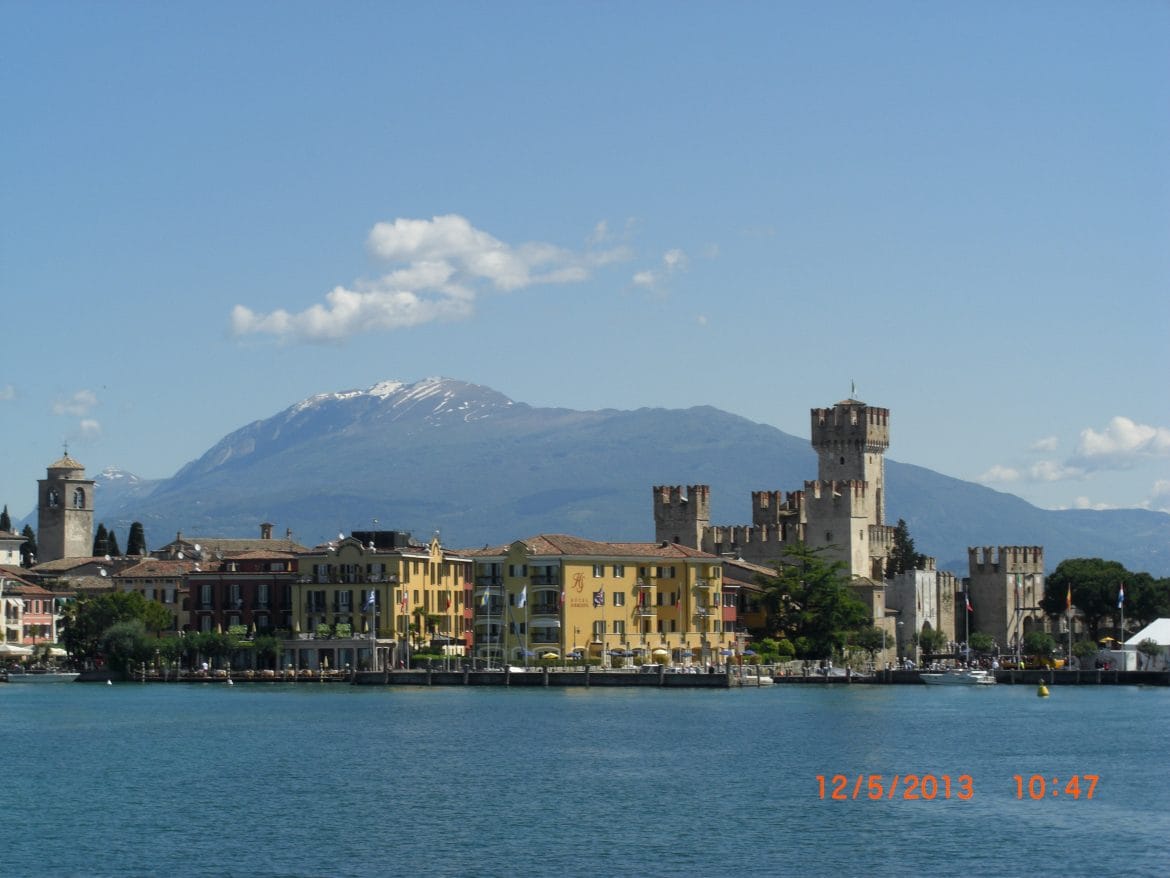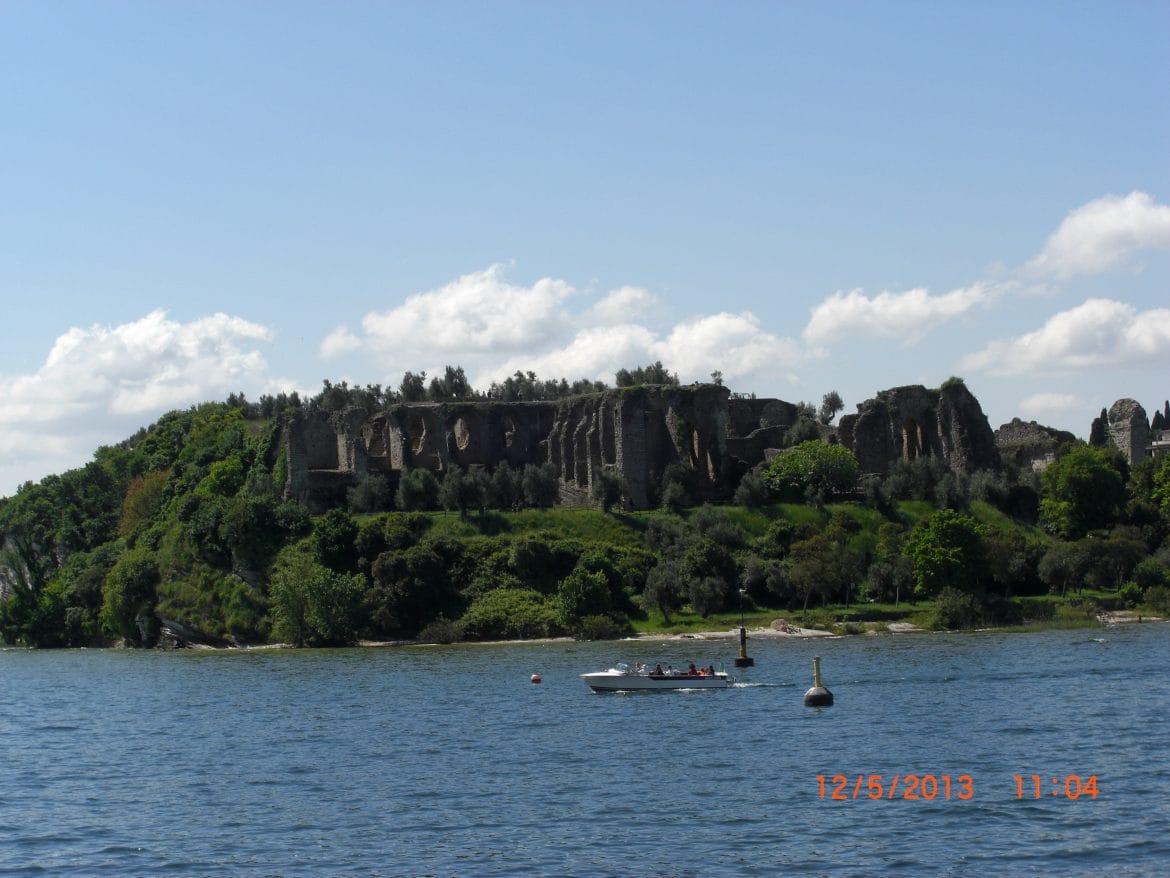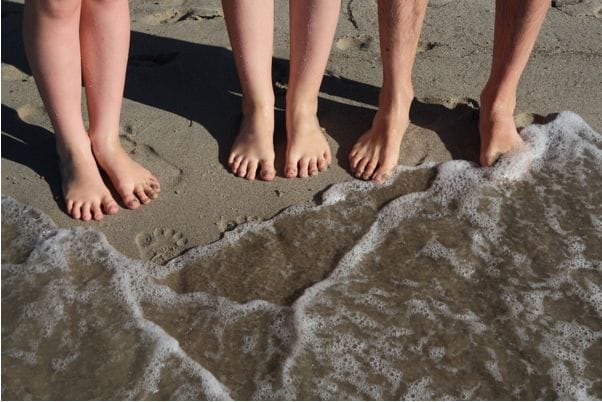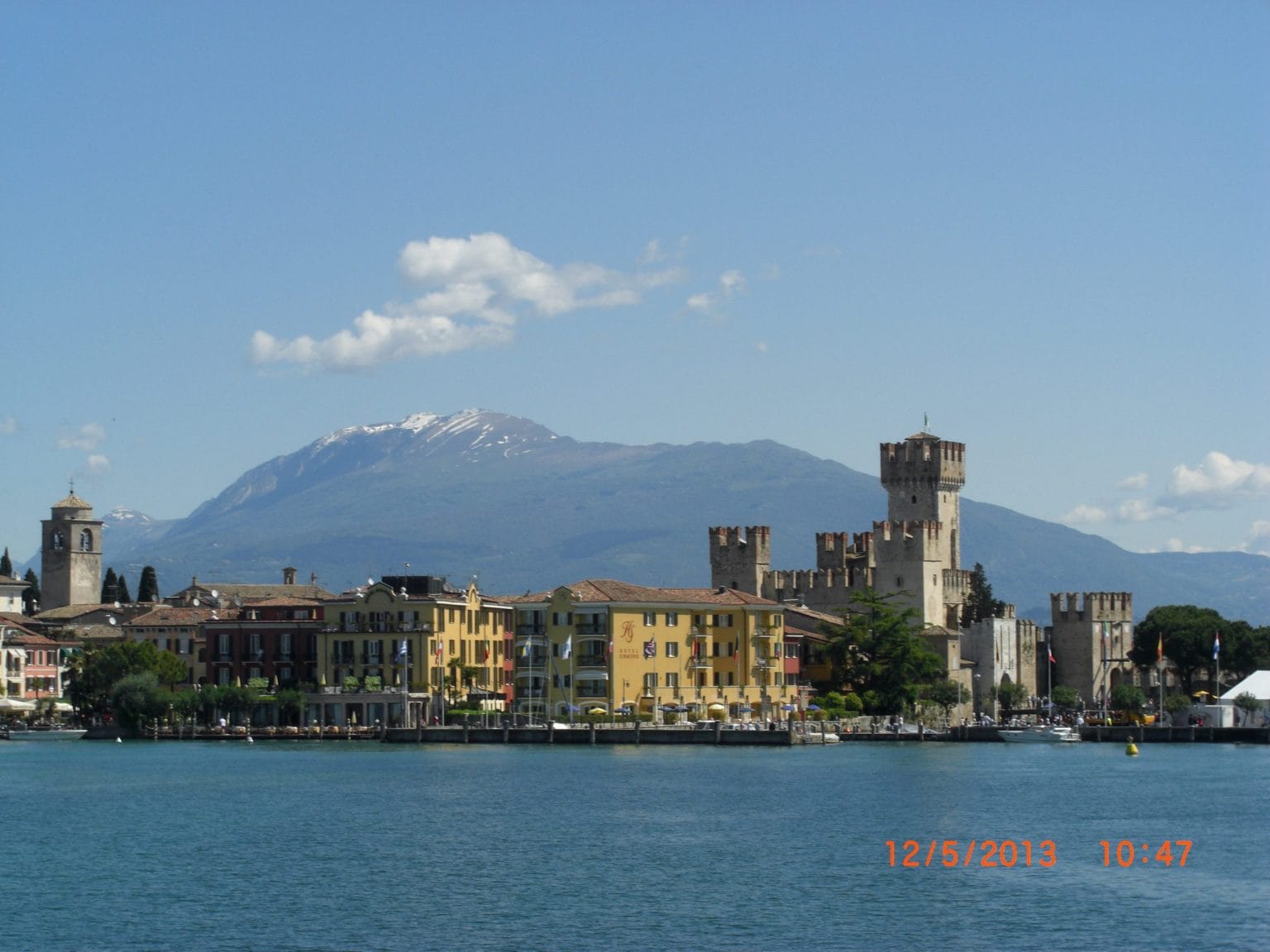Historical Sirmione sits proudly at the head of a peninsular that juts 4 km into the southern reaches of Lake Garda. Spectacular in setting, home to the impressive Castello Scaligera and the famous Grotte di Catullo, it richly merits the accolade the ‘pearl of Lake Garda’.
Getting there
Sirmione is on the route of a regular bus service that runs between Verona and Desenzano, calling at Peschiera. The bus station is conveniently near to both the Tourist Information and the entrance to the historic centre.
But it is the arrival by ferry that reveals Sirmione at its spellbinding best. The Bardolino/ Garda ferry skirts the head of the peninsular granting you views of the awe-inspiring Grotte di Catullo. The approach from Desenzano is a treat that is worth the price of the ferry ticket, particularly if the weather is fine and you are lucky enough to have a front seat on the top deck of one of the big ferries. A trick of perspective sets the peninsular against a background of the distant Monte Balde, and you are likely to watch transfixed as the soft colours and shapes of the historic centre come into focus.
Brief History
Evidence suggests that in pre-historic times Sirmione was home to fisher folk. In the 1st century BCE its congenial environs began to attract wealthy Veronese and Roman families, who built holiday villas towards the tip of the peninsular. The poet Catullus, entranced by its beauty, probably had a villa here.
Its strategic position became apparent, and by the end of the Roman era it was well fortified. Very unsettled times followed the fall of Rome, with successive invasions, Lombard expansion and struggles between supporters of the Pope and supporters of the emperor.
 Enter the Scaliger lords of Verona, who in the early part of the 13th century built the castle that is now such a major landmark. Soon Sirmione was under the dominion of the Venetian Republic (1405-1797), this was followed by a relatively short period of Habsburg control, before it finally took its place in the kingdom of Italy (1860).
Enter the Scaliger lords of Verona, who in the early part of the 13th century built the castle that is now such a major landmark. Soon Sirmione was under the dominion of the Venetian Republic (1405-1797), this was followed by a relatively short period of Habsburg control, before it finally took its place in the kingdom of Italy (1860).
The historic centre
The vibrant, sometimes crowded narrow streets of the historic centre are mercifully almost traffic free. The small piazzas and streets offer a wide variety of shops, restaurants and cafés (those adjacent to the castle can be very busy at lunch time).
Prominently displayed, at 12 sites are photographs of the town taken between 1900 and 1950. Many of the buildings are still recognisable, and in an instant you are transported to a relatively recent, but very different Sirmione.
Sirmione is not all hustle and bustle; beyond the main shopping street are the greener and more tranquil surroundings of the peninsular headland.
The main historical sites
Castello Scaligera
This well preserved castle, which guards the entrance to the old town, is a visual delight. Surrounded by water, it has a large internal dock that originally served as a safe haven for the Scaliger fleet.
Displayed in the entrance arcade is a 2000 year old wooden boat – preserved for millennia in the bed of the river Oglio, it has now been warped by the drying process.
To extract full value from your visit you should head upwards. A climb of just under 80 steps will enable you to walk the castle’s walls. A further 90 or so steps, minding your head at times if you are tall, takes you to the top of the 37m high tower, the old dungeon.
The panoramic views can be described in one word – stunning.
The Grotte di Catullo
At the tip of the peninsular lies one of northern Italy’s treasures – the remains of a huge Roman villa (167 x 105m) known for centuries as the Grottoes of Catullus.
The fact that Catullus died in 54 BCE, maybe one or two centuries before its construction, does not diminish its importance. The site is easily walkable, with well maintained gravel paths and steps to connect the different levels. The structures are evocative, the views superb.
 Near the entrance there is a light, airy museum that houses sections of ancient frescoes together with finds from the peninsular and surrounding area. It is well worth watching a short, very informative film about the site. A touch screen facility allows you to select the language of the commentary, but you may have to wait your turn!
Near the entrance there is a light, airy museum that houses sections of ancient frescoes together with finds from the peninsular and surrounding area. It is well worth watching a short, very informative film about the site. A touch screen facility allows you to select the language of the commentary, but you may have to wait your turn!
The Grottoes of Catullus can be reached by hopping on to a small ‘train’ (il trennino) that runs from the edge of the town. But if you have the energy and the inclination, a not too arduous slightly uphill walk is well worth the effort. Very soon, on the left, you pass the terracotta coloured house where Maria Callas lived. If the day is hot you may opt for a rest in the shade of the ‘Parco Maria Callas’.
Signposted to the left is a short, steepish path leading to San Pietro in Mavino. An easier path to this church, close to the Grottoes of Catullus, may be a welcome alternative. Continuing along the main road you are rewarded by spectacular views across the lake.
Other Attractions
San Pietro in Mavino
Scholars think that a church on this site existed in 756. It was reconstructed in 1320, though the Romanesque bell-tower probably dates from 1070. At the time of writing it was once again undergoing restoration, so for the moment you will miss out on the precious frescoes, dating from the 12th – 15th centuries, which adorn the interior. An adjacent, small, tranquil garden with olive trees offers an opportunity for rest and reflection.
Santa Maria Maggiore
This attractive church is tucked away in the heart of historic Sirmione. The church that existed on this site in the 14th century was partly rebuilt in the late 15th century. Inside there are frescoes, some dating from the 14th century, together with a wooden Madonna from the same period. The stone used for one of the columns of the front porch dates from the Roman period, and allegedly has an inscription by Julian the Apostate.
Thermal Baths
The mineral rich, hot water (69?C) issuing forth from hydrothermal vents in the lake floor was prized by the Romans for its curative properties. It is now piped ashore to supply two commercial spas, one in an attractive location at the far end of the historic centre.
Passeggiata panoramica – the panoramic walk
A sign near the castle directs you to the start of an attractive walk along the lake shore, leading you past bathing areas, and offering an alternative route to the Grottoes of Catullus. Early in the walk, on an elevated path, look out for the ruins of San Salvatore, a church and monastery dating back to the 8th century.




